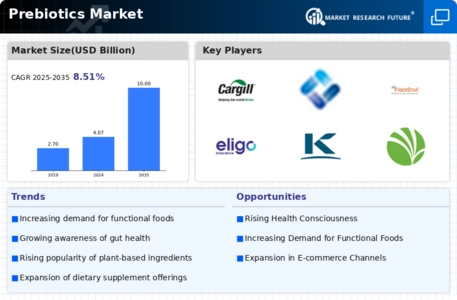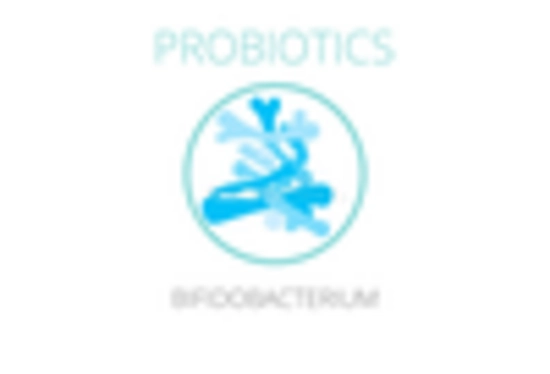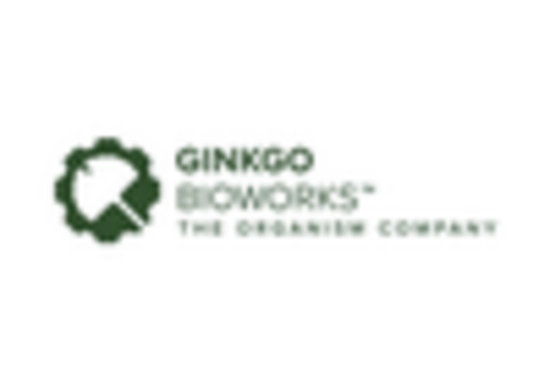Plant-based
Animal-based
Microbial-derived
Powder
Liquid
Capsules
Tablets
Functional Foods
Dietary Supplements
Nutraceuticals
Animal Feed
Food and Beverage
Pharmaceuticals
Personal Care
North America
Europe
South America
Asia Pacific
Middle East and Africa
North America Outlook (USD Billion, 2019-2035)
North America Prebiotics Market by Source Type
Plant-based
Animal-based
Microbial-derived
North America Prebiotics Market by Form Type
Powder
Liquid
Capsules
Tablets
North America Prebiotics Market by Application Type
Functional Foods
Dietary Supplements
Nutraceuticals
Animal Feed
North America Prebiotics Market by End Use Type
Food and Beverage
Pharmaceuticals
Personal Care
North America Prebiotics Market by Regional Type
US
Canada
US Outlook (USD Billion, 2019-2035)
US Prebiotics Market by Source Type
Plant-based
Animal-based
Microbial-derived
US Prebiotics Market by Form Type
Powder
Liquid
Capsules
Tablets
US Prebiotics Market by Application Type
Functional Foods
Dietary Supplements
Nutraceuticals
Animal Feed
US Prebiotics Market by End Use Type
Food and Beverage
Pharmaceuticals
Personal Care
CANADA Outlook (USD Billion, 2019-2035)
CANADA Prebiotics Market by Source Type
Plant-based
Animal-based
Microbial-derived
CANADA Prebiotics Market by Form Type
Powder
Liquid
Capsules
Tablets
CANADA Prebiotics Market by Application Type
Functional Foods
Dietary Supplements
Nutraceuticals
Animal Feed
CANADA Prebiotics Market by End Use Type
Food and Beverage
Pharmaceuticals
Personal Care
Europe Outlook (USD Billion, 2019-2035)
Europe Prebiotics Market by Source Type
Plant-based
Animal-based
Microbial-derived
Europe Prebiotics Market by Form Type
Powder
Liquid
Capsules
Tablets
Europe Prebiotics Market by Application Type
Functional Foods
Dietary Supplements
Nutraceuticals
Animal Feed
Europe Prebiotics Market by End Use Type
Food and Beverage
Pharmaceuticals
Personal Care
Europe Prebiotics Market by Regional Type
Germany
UK
France
Russia
Italy
Spain
Rest of Europe
GERMANY Outlook (USD Billion, 2019-2035)
GERMANY Prebiotics Market by Source Type
Plant-based
Animal-based
Microbial-derived
GERMANY Prebiotics Market by Form Type
Powder
Liquid
Capsules
Tablets
GERMANY Prebiotics Market by Application Type
Functional Foods
Dietary Supplements
Nutraceuticals
Animal Feed
GERMANY Prebiotics Market by End Use Type
Food and Beverage
Pharmaceuticals
Personal Care
UK Outlook (USD Billion, 2019-2035)
UK Prebiotics Market by Source Type
Plant-based
Animal-based
Microbial-derived
UK Prebiotics Market by Form Type
Powder
Liquid
Capsules
Tablets
UK Prebiotics Market by Application Type
Functional Foods
Dietary Supplements
Nutraceuticals
Animal Feed
UK Prebiotics Market by End Use Type
Food and Beverage
Pharmaceuticals
Personal Care
FRANCE Outlook (USD Billion, 2019-2035)
FRANCE Prebiotics Market by Source Type
Plant-based
Animal-based
Microbial-derived
FRANCE Prebiotics Market by Form Type
Powder
Liquid
Capsules
Tablets
FRANCE Prebiotics Market by Application Type
Functional Foods
Dietary Supplements
Nutraceuticals
Animal Feed
FRANCE Prebiotics Market by End Use Type
Food and Beverage
Pharmaceuticals
Personal Care
RUSSIA Outlook (USD Billion, 2019-2035)
RUSSIA Prebiotics Market by Source Type
Plant-based
Animal-based
Microbial-derived
RUSSIA Prebiotics Market by Form Type
Powder
Liquid
Capsules
Tablets
RUSSIA Prebiotics Market by Application Type
Functional Foods
Dietary Supplements
Nutraceuticals
Animal Feed
RUSSIA Prebiotics Market by End Use Type
Food and Beverage
Pharmaceuticals
Personal Care
ITALY Outlook (USD Billion, 2019-2035)
ITALY Prebiotics Market by Source Type
Plant-based
Animal-based
Microbial-derived
ITALY Prebiotics Market by Form Type
Powder
Liquid
Capsules
Tablets
ITALY Prebiotics Market by Application Type
Functional Foods
Dietary Supplements
Nutraceuticals
Animal Feed
ITALY Prebiotics Market by End Use Type
Food and Beverage
Pharmaceuticals
Personal Care
SPAIN Outlook (USD Billion, 2019-2035)
SPAIN Prebiotics Market by Source Type
Plant-based
Animal-based
Microbial-derived
SPAIN Prebiotics Market by Form Type
Powder
Liquid
Capsules
Tablets
SPAIN Prebiotics Market by Application Type
Functional Foods
Dietary Supplements
Nutraceuticals
Animal Feed
SPAIN Prebiotics Market by End Use Type
Food and Beverage
Pharmaceuticals
Personal Care
REST OF EUROPE Outlook (USD Billion, 2019-2035)
REST OF EUROPE Prebiotics Market by Source Type
Plant-based
Animal-based
Microbial-derived
REST OF EUROPE Prebiotics Market by Form Type
Powder
Liquid
Capsules
Tablets
REST OF EUROPE Prebiotics Market by Application Type
Functional Foods
Dietary Supplements
Nutraceuticals
Animal Feed
REST OF EUROPE Prebiotics Market by End Use Type
Food and Beverage
Pharmaceuticals
Personal Care
APAC Outlook (USD Billion, 2019-2035)
APAC Prebiotics Market by Source Type
Plant-based
Animal-based
Microbial-derived
APAC Prebiotics Market by Form Type
Powder
Liquid
Capsules
Tablets
APAC Prebiotics Market by Application Type
Functional Foods
Dietary Supplements
Nutraceuticals
Animal Feed
APAC Prebiotics Market by End Use Type
Food and Beverage
Pharmaceuticals
Personal Care
APAC Prebiotics Market by Regional Type
China
India
Japan
South Korea
Malaysia
Thailand
Indonesia
Rest of APAC
CHINA Outlook (USD Billion, 2019-2035)
CHINA Prebiotics Market by Source Type
Plant-based
Animal-based
Microbial-derived
CHINA Prebiotics Market by Form Type
Powder
Liquid
Capsules
Tablets
CHINA Prebiotics Market by Application Type
Functional Foods
Dietary Supplements
Nutraceuticals
Animal Feed
CHINA Prebiotics Market by End Use Type
Food and Beverage
Pharmaceuticals
Personal Care
INDIA Outlook (USD Billion, 2019-2035)
INDIA Prebiotics Market by Source Type
Plant-based
Animal-based
Microbial-derived
INDIA Prebiotics Market by Form Type
Powder
Liquid
Capsules
Tablets
INDIA Prebiotics Market by Application Type
Functional Foods
Dietary Supplements
Nutraceuticals
Animal Feed
INDIA Prebiotics Market by End Use Type
Food and Beverage
Pharmaceuticals
Personal Care
JAPAN Outlook (USD Billion, 2019-2035)
JAPAN Prebiotics Market by Source Type
Plant-based
Animal-based
Microbial-derived
JAPAN Prebiotics Market by Form Type
Powder
Liquid
Capsules
Tablets
JAPAN Prebiotics Market by Application Type
Functional Foods
Dietary Supplements
Nutraceuticals
Animal Feed
JAPAN Prebiotics Market by End Use Type
Food and Beverage
Pharmaceuticals
Personal Care
SOUTH KOREA Outlook (USD Billion, 2019-2035)
SOUTH KOREA Prebiotics Market by Source Type
Plant-based
Animal-based
Microbial-derived
SOUTH KOREA Prebiotics Market by Form Type
Powder
Liquid
Capsules
Tablets
SOUTH KOREA Prebiotics Market by Application Type
Functional Foods
Dietary Supplements
Nutraceuticals
Animal Feed
SOUTH KOREA Prebiotics Market by End Use Type
Food and Beverage
Pharmaceuticals
Personal Care
MALAYSIA Outlook (USD Billion, 2019-2035)
MALAYSIA Prebiotics Market by Source Type
Plant-based
Animal-based
Microbial-derived
MALAYSIA Prebiotics Market by Form Type
Powder
Liquid
Capsules
Tablets
MALAYSIA Prebiotics Market by Application Type
Functional Foods
Dietary Supplements
Nutraceuticals
Animal Feed
MALAYSIA Prebiotics Market by End Use Type
Food and Beverage
Pharmaceuticals
Personal Care
THAILAND Outlook (USD Billion, 2019-2035)
THAILAND Prebiotics Market by Source Type
Plant-based
Animal-based
Microbial-derived
THAILAND Prebiotics Market by Form Type
Powder
Liquid
Capsules
Tablets
THAILAND Prebiotics Market by Application Type
Functional Foods
Dietary Supplements
Nutraceuticals
Animal Feed
THAILAND Prebiotics Market by End Use Type
Food and Beverage
Pharmaceuticals
Personal Care
INDONESIA Outlook (USD Billion, 2019-2035)
INDONESIA Prebiotics Market by Source Type
Plant-based
Animal-based
Microbial-derived
INDONESIA Prebiotics Market by Form Type
Powder
Liquid
Capsules
Tablets
INDONESIA Prebiotics Market by Application Type
Functional Foods
Dietary Supplements
Nutraceuticals
Animal Feed
INDONESIA Prebiotics Market by End Use Type
Food and Beverage
Pharmaceuticals
Personal Care
REST OF APAC Outlook (USD Billion, 2019-2035)
REST OF APAC Prebiotics Market by Source Type
Plant-based
Animal-based
Microbial-derived
REST OF APAC Prebiotics Market by Form Type
Powder
Liquid
Capsules
Tablets
REST OF APAC Prebiotics Market by Application Type
Functional Foods
Dietary Supplements
Nutraceuticals
Animal Feed
REST OF APAC Prebiotics Market by End Use Type
Food and Beverage
Pharmaceuticals
Personal Care
South America Outlook (USD Billion, 2019-2035)
South America Prebiotics Market by Source Type
Plant-based
Animal-based
Microbial-derived
South America Prebiotics Market by Form Type
Powder
Liquid
Capsules
Tablets
South America Prebiotics Market by Application Type
Functional Foods
Dietary Supplements
Nutraceuticals
Animal Feed
South America Prebiotics Market by End Use Type
Food and Beverage
Pharmaceuticals
Personal Care
South America Prebiotics Market by Regional Type
Brazil
Mexico
Argentina
Rest of South America
BRAZIL Outlook (USD Billion, 2019-2035)
BRAZIL Prebiotics Market by Source Type
Plant-based
Animal-based
Microbial-derived
BRAZIL Prebiotics Market by Form Type
Powder
Liquid
Capsules
Tablets
BRAZIL Prebiotics Market by Application Type
Functional Foods
Dietary Supplements
Nutraceuticals
Animal Feed
BRAZIL Prebiotics Market by End Use Type
Food and Beverage
Pharmaceuticals
Personal Care
MEXICO Outlook (USD Billion, 2019-2035)
MEXICO Prebiotics Market by Source Type
Plant-based
Animal-based
Microbial-derived
MEXICO Prebiotics Market by Form Type
Powder
Liquid
Capsules
Tablets
MEXICO Prebiotics Market by Application Type
Functional Foods
Dietary Supplements
Nutraceuticals
Animal Feed
MEXICO Prebiotics Market by End Use Type
Food and Beverage
Pharmaceuticals
Personal Care
ARGENTINA Outlook (USD Billion, 2019-2035)
ARGENTINA Prebiotics Market by Source Type
Plant-based
Animal-based
Microbial-derived
ARGENTINA Prebiotics Market by Form Type
Powder
Liquid
Capsules
Tablets
ARGENTINA Prebiotics Market by Application Type
Functional Foods
Dietary Supplements
Nutraceuticals
Animal Feed
ARGENTINA Prebiotics Market by End Use Type
Food and Beverage
Pharmaceuticals
Personal Care
REST OF SOUTH AMERICA Outlook (USD Billion, 2019-2035)
REST OF SOUTH AMERICA Prebiotics Market by Source Type
Plant-based
Animal-based
Microbial-derived
REST OF SOUTH AMERICA Prebiotics Market by Form Type
Powder
Liquid
Capsules
Tablets
REST OF SOUTH AMERICA Prebiotics Market by Application Type
Functional Foods
Dietary Supplements
Nutraceuticals
Animal Feed
REST OF SOUTH AMERICA Prebiotics Market by End Use Type
Food and Beverage
Pharmaceuticals
Personal Care
MEA Outlook (USD Billion, 2019-2035)
MEA Prebiotics Market by Source Type
Plant-based
Animal-based
Microbial-derived
MEA Prebiotics Market by Form Type
Powder
Liquid
Capsules
Tablets
MEA Prebiotics Market by Application Type
Functional Foods
Dietary Supplements
Nutraceuticals
Animal Feed
MEA Prebiotics Market by End Use Type
Food and Beverage
Pharmaceuticals
Personal Care
MEA Prebiotics Market by Regional Type
GCC Countries
South Africa
Rest of MEA
GCC COUNTRIES Outlook (USD Billion, 2019-2035)
GCC COUNTRIES Prebiotics Market by Source Type
Plant-based
Animal-based
Microbial-derived
GCC COUNTRIES Prebiotics Market by Form Type
Powder
Liquid
Capsules
Tablets
GCC COUNTRIES Prebiotics Market by Application Type
Functional Foods
Dietary Supplements
Nutraceuticals
Animal Feed
GCC COUNTRIES Prebiotics Market by End Use Type
Food and Beverage
Pharmaceuticals
Personal Care
SOUTH AFRICA Outlook (USD Billion, 2019-2035)
SOUTH AFRICA Prebiotics Market by Source Type
Plant-based
Animal-based
Microbial-derived
SOUTH AFRICA Prebiotics Market by Form Type
Powder
Liquid
Capsules
Tablets
SOUTH AFRICA Prebiotics Market by Application Type
Functional Foods
Dietary Supplements
Nutraceuticals
Animal Feed
SOUTH AFRICA Prebiotics Market by End Use Type
Food and Beverage
Pharmaceuticals
Personal Care
REST OF MEA Outlook (USD Billion, 2019-2035)
REST OF MEA Prebiotics Market by Source Type
Plant-based
Animal-based
Microbial-derived
REST OF MEA Prebiotics Market by Form Type
Powder
Liquid
Capsules
Tablets
REST OF MEA Prebiotics Market by Application Type
Functional Foods
Dietary Supplements
Nutraceuticals
Animal Feed
REST OF MEA Prebiotics Market by End Use Type
Food and Beverage
Pharmaceuticals
Personal Care









Leave a Comment